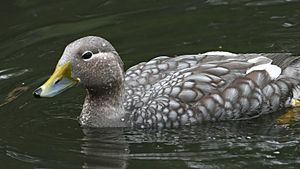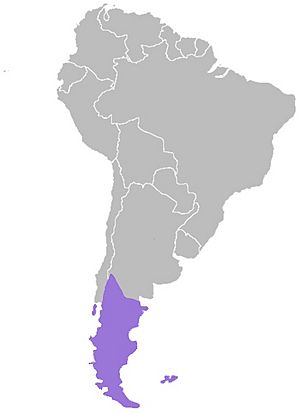Flying steamer duck facts for kids
Quick facts for kids Flying steamer duck |
|
|---|---|
 |
|
| Conservation status | |
| Scientific classification | |
| Genus: |
Tachyeres
|
| Species: |
patachonicus
|
 |
|
| Distribution map for flying steamer ducks (T. patachonicus) | |
The flying steamer duck (Tachyeres patachonicus) is a unique type of duck found in South America. It belongs to the Anatidae family, which includes ducks, geese, and swans. This duck is special because it's the only one of its kind that can actually fly!
Contents
What is a Steamer Duck?
The flying steamer duck is one of four types of steamer ducks in the Tachyeres group. The other three are the Fuegian steamer duck, the Chubut steamer duck, and the Falkland steamer duck. They are called "steamer ducks" because of how they move. When they paddle across the water, using their wings and feet, it looks a lot like an old-fashioned steamboat.
Even though it's called the flying steamer duck, some very large male flying steamer ducks might not be able to fly. This is because they are too heavy for their wings. Unlike the other steamer ducks, this species can live in fresh water far from the ocean.
How to Spot a Flying Steamer Duck
Flying steamer ducks are the smallest of the four steamer duck species. They have brown feathers on their heads and necks. You can spot white stripes that go from their eyes all the way to the back of their necks. Their bodies are a mix of brown and gray, and their bellies are mostly white. They also have bright orange feet.
Differences Between Males and Females
Male and female flying steamer ducks look a bit different, which is called sexual dimorphism. Females have smaller bills that are orange with black tips. Males have darker gray bills with a little bit of yellow. Males are also heavier than females, but females have slightly larger wings.
Both males and females have hard, orange bumps on their wings. These bumps are used by males during fights with other ducks. They also use them when showing off to attract a mate.
Their Unique Calls
Flying steamer ducks make sounds that are like grunts. Female grunts are usually lower pitched and come out in quick bursts. Males have three different grunts that can sound like whistles. These include a 'rasping' grunt, a 'ticking' grunt, and a 'sibilant' grunt.
Where Flying Steamer Ducks Live
Flying steamer ducks live in watery areas at the very southern tip of South America. You can find them in Chile and Argentina, including a region called Tierra del Fuego. They also live on the Falkland Islands.
Because they can fly, flying steamer ducks are found in more places than the other steamer duck species. They live in both freshwater lakes and rivers, and in salty ocean environments.
Flying Steamer Duck Behavior
Breeding Habits
Scientists don't know a lot about how flying steamer ducks breed. They seem to stay with one partner for a long time and are often seen in pairs. Their mating ritual is quite special. The male and female start by dipping their bills into the water faster and faster. Then, the female almost completely goes underwater, and the male climbs onto her back. After that, both ducks raise their bills high into the air and make loud grunting sounds.
What They Eat
Flying steamer ducks usually look for food in pairs. They like to dive for food around deep kelp beds or in shallow water areas. They eat mollusks (like snails and clams) and crustaceans (like crabs and shrimp). They also eat other small sea creatures without backbones.
Threats and Aggression
Flying steamer ducks face some dangers, especially when their nests are attacked. Predators like Chimango Caracaras, Crested Caracaras, the Fuegian Culpeo Fox, and the American mink (which was brought to the area) eat their eggs.
Besides nest predators, flying steamer ducks are mostly threatened by competition for food. They are known for being very feisty and often aggressive towards other ducks and even other species. They might attack other birds even if those birds are not a threat or competing for food. For example, they have been seen attacking whole groups of Silvery grebes and Hooded grebes. They have even been known to kill Red shovelers for no clear reason. When male flying steamer ducks attack, they grab their opponent by the neck and hit them on the head, neck, or body using the hard bumps on their wings.
Conservation Status
Good news! The flying steamer duck is not an endangered species. It is listed as a Least Concern species, which means there are plenty of them around. However, there have been reports of more American minks eating the nests of flightless steamer ducks in Tierra del Fuego. This could become a problem for duck populations in the future.
See also
 In Spanish: Pato vapor volador para niños
In Spanish: Pato vapor volador para niños


